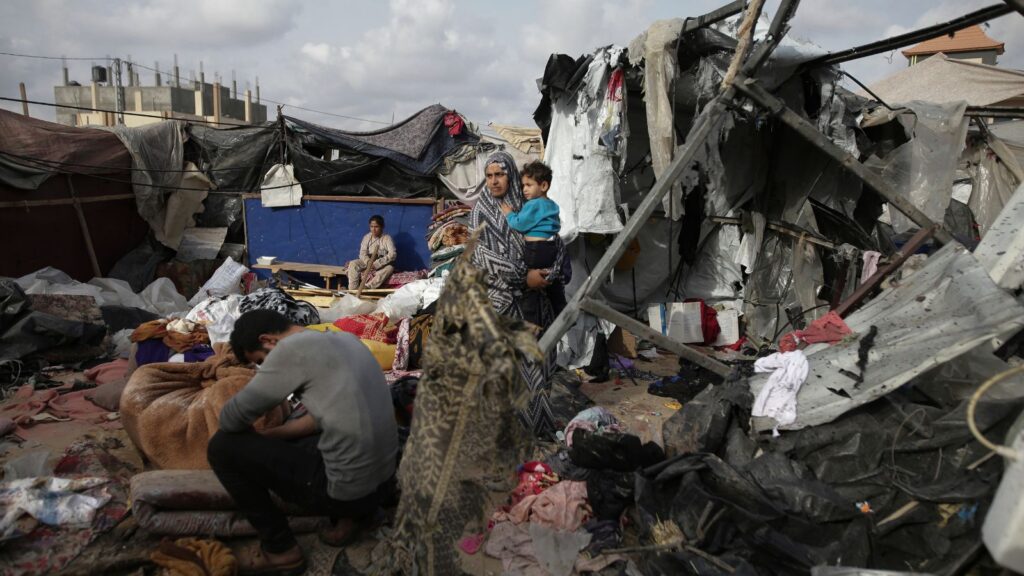Israeli forces attacked Rafah in the southern Gaza Strip and other areas in the Gaza Strip on Friday, killing at least 45 Palestinians in close combat with Hamas fighters, residents and the Israeli military said.
Residents said Israeli forces appeared to be close to completing their takeover of Rafah, which borders Egypt and has been the focus of Israeli offensives since early May.
Tanks had already seized the eastern, southern and central parts of the city and were advancing into the western and northern parts. Aircraft, tank and ship bombardment off the coast had forced more than a million refugees to flee the city, but new waves of refugees were arriving, forcing many to flee again.
Gaza’s health ministry said at least 25 Palestinians were killed and 50 wounded in the town of Mawashi, west of Rafah, when Palestinians said tank shells hit tents housing displaced people.
“Two tanks climbed to the top of a hill overlooking Mawashi and fired fireballs, hitting the tents of poor people who had taken refuge in the area,” one resident told Reuters via a chat app.
Palestinian health officials said at least 45 Palestinians were killed in Friday’s Israeli attack. The Israeli army said it was investigating the attack in Mawashi and another incident in Gaza City. It said it had carried out actions “based on precise intelligence” in the Rafah neighborhood, where troops had engaged in close combat and identified the location of tunnels used by militants.
The army also said troops had targeted a university that served as a Hamas stronghold over the past week, where militants had opened fire on soldiers and found weapons and barrel bombs, without naming the university.
In central Nuseirat, the army said it had killed dozens of fighters over the past week and uncovered an arms cache storing Hamas-affiliated mortars and military equipment. Some residents said the Israeli military’s onslaught on Rafah had intensified over the past two days, with explosions and gunfire almost constant.
“Last night was one of the worst in western Rafah. Drones, planes, tanks and navy ships bombarded the area. We feel the occupiers are trying to complete their control of the city,” Hatem, 45, said in a text message. “They are under heavy fire from the resistance and that may be slowing them down.”
Attacks on Khan Yunis and Gaza City
More than eight months into the war in Gaza, Israeli forces are now focused on the last two areas they have yet to seize: around Rafah on the southern edge of Gaza, and Deir al-Bala in the center.
“The entire city of Rafah is an Israeli military operational zone,” Rafah Mayor Ahmed al-Sofi said in a statement carried by Hamas media on Friday. “The city is facing a humanitarian catastrophe, with people dying in their tents due to Israeli bombardment.”
Sofi said there were no functioning medical facilities in the city and remaining residents and displaced families lacked even basic necessities such as food and water.
Fewer than 100,000 people may remain in the western edge of the city, where more than half of Gaza’s 2.3 million residents were displaced before the Israeli offensive began in early May, according to Palestinian and UN figures.
In nearby Khan Yunis, an Israeli airstrike killed three people, including a father and son, on Friday, medical sources said.
At the same time, Israeli forces launched a new offensive into the outskirts of Gaza City in the northern Gaza Strip, battling Hamas-led militants.
Israeli forces destroyed many homes in central Gaza City on Thursday, residents said. Five people, including four city workers, were killed in Israeli airstrikes on Friday, according to Gaza City’s Civil Emergency Service. Rescue teams are searching the rubble for missing victims.
At least seven people were killed in the nearby Beach Camp when Israeli airstrikes hit homes, medical sources said.
Israel’s ground and air campaign began on Oct. 7 when Hamas-led militants stormed into southern Israel, leaving about 1,200 people dead and more than 250 taken hostage, according to an Israeli tally.
The attack has left Gaza in ruins, killing more than 37,400 people and leaving almost the entire population homeless and impoverished, according to Palestinian health officials.

